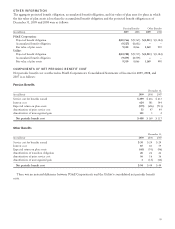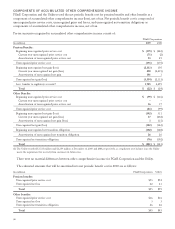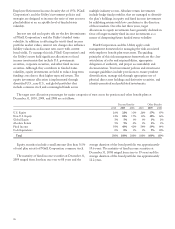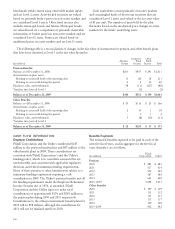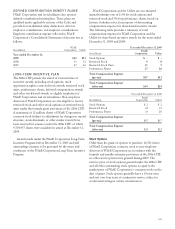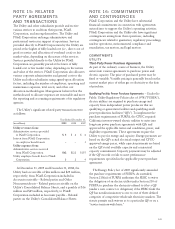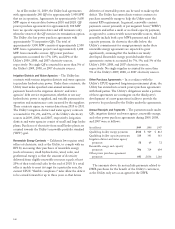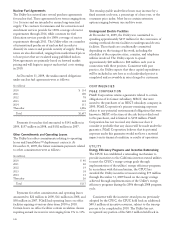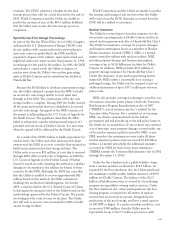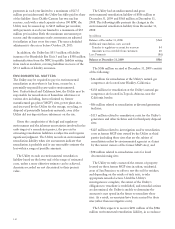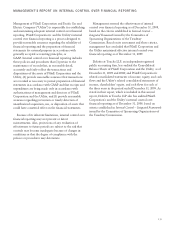PG&E 2009 Annual Report Download - page 108
Download and view the complete annual report
Please find page 108 of the 2009 PG&E annual report below. You can navigate through the pages in the report by either clicking on the pages listed below, or by using the keyword search tool below to find specific information within the annual report.
As of December 31, 2009, $63 million was accrued as
the performance share liability for PG&E Corporation, of
which $42 million related to Utility employees. The
number of performance shares that were outstanding at
December 31, 2009 was 1,547,113, of which 1,139,970 was
related to Utility employees. Outstanding performance
shares are classified as a liability on the Consolidated
Balance Sheets of PG&E Corporation and the Utility
because the performance shares can only be settled in cash.
The liability related to the performance shares is marked to
market at the end of each reporting period to reflect the
market price of PG&E Corporation common stock and the
payout percentage at the end of the reporting period.
Accordingly, compensation expense recognized for
performance shares will fluctuate with PG&E Corporation’s
common stock price and its TSR relative to its comparator
group.
NOTE 14: RESOLUTION OF
REMAINING CHAPTER 11
DISPUTED CLAIMS
As part of the Utility’s plan of reorganization under
Chapter 11, which became effective on April 12, 2004, the
Utility established an escrow account for the resolution of
certain disputed claims. These claims were filed by various
electricity suppliers seeking payment for energy supplied to
the Utility’s customers through the wholesale electricity
markets operated by the CAISO and the California Power
Exchange (“PX”) between May 2000 and June 2001. These
claims are being addressed in various FERC and judicial
proceedings in which the State of California, the Utility,
and other electricity purchasers are seeking refunds from
electricity suppliers, including municipal and governmental
entities, for overcharges incurred in the CAISO and the PX
wholesale electricity markets between May 2000 and June
2001. At December 31, 2009 and December 31, 2008, the
Utility held $515 million and $1,212 million, respectively,
in escrow, including interest earned, for payment of the
remaining net disputed claims. These amounts are included
within Restricted cash on the Consolidated Balance Sheets.
While the FERC and judicial proceedings have been
pending, the Utility entered into a number of settlements
with various electricity suppliers to resolve some of these
disputed claims and to resolve the Utility’s refund claims
against these electricity suppliers. These settlement
agreements provide that the amounts payable by the parties
are, in some instances, subject to adjustment based on the
outcome of the various refund offset and interest issues
being considered by the FERC. The proceeds from these
settlements, after deductions for contingencies based on
the outcome of the various refund offset and interest issues
being considered by the FERC, will continue to be
refunded to customers in rates. Additional settlement
discussions with other electricity suppliers are
ongoing. Any net refunds, claim offsets, or other credits
that the Utility receives from energy suppliers through
resolution of the remaining disputed claims, either through
settlement or the conclusion of the various FERC and
judicial proceedings, will also be credited to customers.
On August 26, 2009, the Utility paid $700 million to
the PX from the Utility’s escrow account to reduce the
Utility’s liability for the remaining net disputed claims. The
following table presents the changes in the remaining
disputed claims liability and interest accrued from
December 31, 2008:
(in millions)
Balance at December 31, 2008 $1,750
Interest accrued 53
Less: Supplier Settlements (157)
Less: August 26, 2009 Payment (700)
Balance at December 31, 2009 $ 946
At December 31, 2009, the Utility’s net disputed claims
liability was $946 million, consisting of $773 million of
remaining disputed claims (classified on the Consolidated
Balance Sheets within Accounts payable — Disputed claims
and customer refunds) and interest accrued at the FERC-
ordered rate of $667 million (classified on the
Consolidated Balance Sheets within Interest payable) offset
by accounts receivable from the CAISO and the PX of
$494 million (classified on the Consolidated Balance
Sheets within Accounts receivable — Customers).
Interest accrues on the liability for disputed claims at the
FERC-ordered rate, which is higher than the rate earned by
the Utility on the escrow balance. Although the Utility has
been collecting the difference between the accrued interest
and the earned interest from customers, this amount is not
held in escrow. If the amount of interest accrued at the
FERC-ordered rate is greater than the amount of interest
ultimately determined to be owed with respect to disputed
claims, the Utility would refund to customers any excess
net interest collected from customers. The amount of any
interest that the Utility may be required to pay will depend
on the final amounts to be paid by the Utility with respect
to the disputed claims.
PG&E Corporation and the Utility are unable to predict
when the FERC or judicial proceedings that are still
pending will be resolved, and the amount of any potential
refunds that the Utility may receive or the amount of
disputed claims, including interest, that the Utility will be
required to pay.
104



